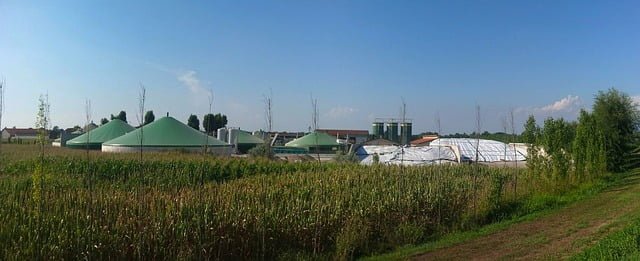Anaerobic Digestion vs Wind Energy: A Comparison of Renewable Energy Sources
In today’s world, the importance of renewable energy sources cannot be overstated. Two popular options for renewable energy production are anaerobic digestion and wind energy. In this informative comparison, we will explore the benefits of anaerobic digestion and wind energy, how they differ, and which may be more suitable for your energy needs.
We nearly called this article “why flatulence (#biogas) is better than wind”, but we decided that it was a little bit too flippant for such a serious subject. There are in fact that least five reasons why #anaerobic digestion as an energy source, is better than #wind energy. We know that statement might surprise our readers, and if that is you to read on, and we hope you will think differently by the end of this article.
What is Anaerobic Digestion?
Anaerobic digestion is a natural process that breaks down organic materials, such as food waste and agricultural residues, to produce biogas. This biogas can be used as a renewable energy source for electricity generation, heating, and transportation fuel. The process also produces nutrient-rich digestate, which can be used as a fertilizer.
What is Wind Energy?
Wind energy is generated by harnessing the power of wind to turn turbines, which then convert the kinetic energy into electricity. Wind energy is a clean and renewable source of power that can be used to generate electricity for homes, businesses, and communities.
Comparison of Anaerobic Digestion and Wind Energy
Anaerobic Digestion power is “always on”
Anaerobic Digestion power is “always on” 24/7/365 wheras wind turbines only produce electricity when there is wind, neither to slow or too fast, to turn the turbine blades.
The most important fact that outstrips all others, and we make no apology for placing first in in our list, is that AD Plants generate electricity 24 hours every day. A reliable and well run anaerobic digestion plant will provide a base load of electrical power 24/7 and 365 days a year, every year.
Until technology finds a low-cost and reliable way to store electricity, or to store energy which is ready on-tap for use on-demand, when people want to use it, it will remain necessary to maintain fossil fuel generating capacity alongside all the wind farm capacity.
The true cost of wind energy should therefore be calculated on the basis of the cost of the wind energy itself, plus the cost of maintaining a fossil-fuel powered power station capable of delivering the energy of the wind farm, and to do that while being on-call at a moment’s notice, ready for when the wind stops.
Although, the reserve backup capacity may not need to be 100% of the wind farm generating capacity, if the power grid extends over an extremely large geographical area. The above reserve capacity then provided, can only be less than 100%, if it can be shown that there will be no occasions when all wind farms in the grid feed area, would never all be becalmed simultaneously.
Cost-effectiveness
When it comes to cost-effectiveness, anaerobic digestion and wind energy both have their advantages. Anaerobic digestion may have higher initial costs but can provide a steady source of renewable energy and revenue from biogas production. Wind energy, on the other hand, may have lower operating costs but can be more dependent on wind availability.
The true cost of wind energy should therefore be calculated on the basis of the cost of the wind energy itself, plus the cost of maintaining a fossil-fuel powered power station capable of delivering the energy of the wind farm, and to do that while being on-call at a moment’s notice, ready for when the wind stops.
Although, the reserve backup capacity may not need to be 100% of the wind farm generating capacity, if the power grid extends over an extremely large geographical area. The above reserve capacity then provided, can only be less than 100%, if it can be shown that there will be no occasions when all wind farms in the grid feed area, would never all be becalmed simultaneously.
Winter farm subsidies, are not based on this presumption and therefore are subsidized at an unrealistically high level by governments. By contrast, anaerobic digestion power, due to its continuous baseline supply capability, holds none of these hidden costs. Which also include, the use in the case of wind energy, unsustainable energy in the form of carbonaceous fuel consumption
Environmental Impact
Both anaerobic digestion and wind energy have positive environmental impacts. Anaerobic digestion helps reduce greenhouse gas emissions by capturing methane from organic waste, while wind energy produces no greenhouse gas emissions during operation.
Anaerobic digestion is better than wind farms, because most anaerobic digestion consumes waste, this waste would have a harmful environmental impact if it was not digested. Clearly some wastes are more hazardous to the environment than others. The biggest advantage to the environment when a waste is digested comes from digesting food waste. Food waste increases the risk that the environment will be damaged by polluting emissions if it is placed in landfills. However, all of organic waste is less hazardous to the environment once it has been digested. Not only that, anaerobic digestion contains a pasteurization stage during which it is sanitised and any pathogens present, and seeds, will be killed.
Efficiency
When it comes to efficiency, anaerobic digestion can convert a higher percentage of organic waste into biogas compared to wind energy’s conversion of wind into electricity. However, wind energy can be more efficient in terms of electricity generation per unit of land area.
Reliability
Reliability is an important factor to consider when choosing a renewable energy source. Anaerobic digestion can provide a steady source of energy production, while wind energy’s reliability depends on wind availability. Combining both sources can help ensure a more reliable energy supply.
Scalability
Anaerobic digestion and wind energy can both be scaled up or down to meet different energy needs. Anaerobic digestion can be implemented on a small scale for individual farms or communities, while wind energy projects can range from small turbines for homes to large wind farms for utility-scale electricity generation.
Suitability for Different Locations
When considering the suitability of anaerobic digestion and wind energy for different locations, factors such as wind availability, land availability, and feedstock availability need to be taken into account. Anaerobic digestion may be more suitable for areas with abundant organic waste, while wind energy may be more suitable for areas with consistent wind patterns.
Government Incentives and Regulations
Both anaerobic digestion and wind energy are eligible for government incentives and regulations that promote renewable energy production. These incentives can help offset the initial costs of implementing renewable energy projects and make them more financially viable.
Local Jobs

A wind farm, once it has been constructed and commissioned, provides very little in the way of jobs for local people. By contrast, an anaerobic digestion plant will require at least one, possibly more, plant operators for as long as it is in use.
Wildlife – Bird Hits
The turbine blades at wind farms provide a hazard to birdlife. An anaerobic digestion plant does not provide any hazard to birdlife.
Noise
The motion of wind turbine blades produces noise which can be heard over very long distances. An anaerobic digestion plant, may produce some noise which is potentially audible to those within about 50 metres of an AD plant. Noise nuisance from AD plants is orders of magnitude less intense.
Although anaerobic digesters don’t actually kill any birds, they can be described as able to have benefits that “kill three birds with one stone“, because they produce renewable energy, treat waste, and provide a valuable agricultural fertilizer.
It may be a little bit unkind, to say that:
Wind turbines, in comparison, kill three birds with one blade!
However, the reader will by now have picked up the views of the author in respect of wind energy… All the author would ask of governments which promote wind energy, that they set tariffs and other incentives at a level which reflects the fact that wind energy is not such a good (nor economic) provider of energy as it might appear to be at first sight.
Frequently Asked Questions
What is the difference between anaerobic digestion and wind energy?
The key difference between anaerobic digestion and wind energy lies in the way they generate renewable energy. Anaerobic digestion converts organic waste into biogas, while wind energy harnesses the power of wind to generate electricity.
Which is more cost-effective, anaerobic digestion or wind energy?
The cost-effectiveness of anaerobic digestion and wind energy depends on various factors, such as initial costs, operating costs, and revenue generation. Anaerobic digestion may have higher initial costs but can provide a steady source of revenue from biogas production, while wind energy may have lower operating costs but can be more dependent on wind availability.
Are there any environmental benefits to using anaerobic digestion or wind energy?
Both anaerobic digestion and wind energy have positive environmental benefits. Anaerobic digestion helps reduce greenhouse gas emissions by capturing methane from organic waste, while wind energy produces no greenhouse gas emissions during operation.
How reliable are anaerobic digestion and wind energy as sources of energy?
Anaerobic digestion can provide a steady source of energy production, while wind energy’s reliability depends on wind availability. Combining both sources can help ensure a more reliable energy supply.
Can anaerobic digestion and wind energy be used in combination?
A combination of anaerobic digestion and wind energy can help provide a more reliable and diverse source of renewable energy. Anaerobic digestion can provide a steady source of energy production, while wind energy can supplement the energy supply during periods of low wind availability.
Are there any government incentives for using anaerobic digestion or wind energy?
Both anaerobic digestion and wind energy are eligible for government incentives and regulations that promote renewable energy production. These incentives can help offset the initial costs of implementing renewable energy projects and make them more financially viable.
Which renewable energy source is more suitable for my needs, anaerobic digestion or wind energy?
When choosing between anaerobic digestion and wind energy for your energy needs, factors such as cost-effectiveness, environmental impact, reliability, scalability, and government incentives need to be considered. Consulting with renewable energy experts can help determine which source is more suitable for your specific energy needs.
UK incentives to wind energy which are comparable to, or greater than, anaerobic digestion facilities are illogical. So, we return to where we started this article and repeat that; “flatulence, not wind, (anaerobic digestion) is the way to go”.





Leave a Reply